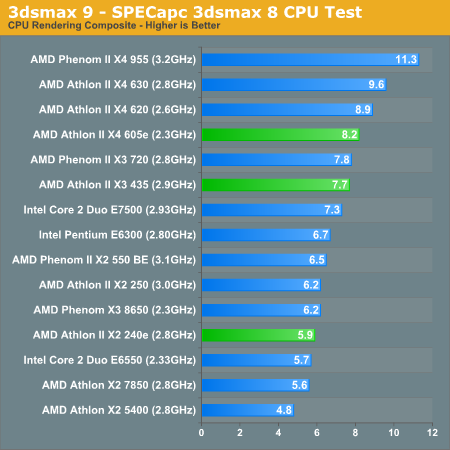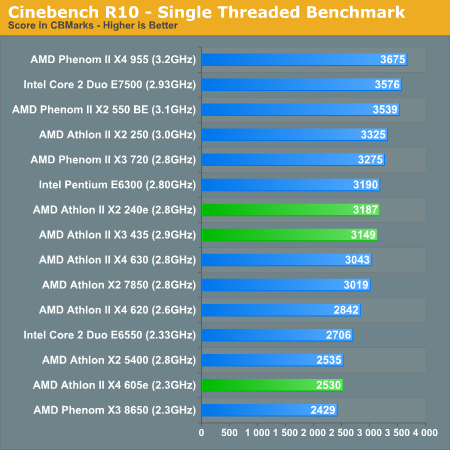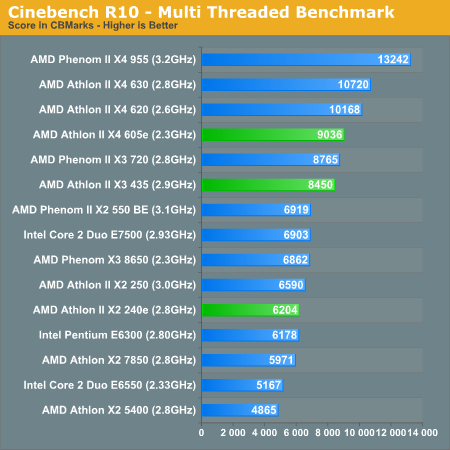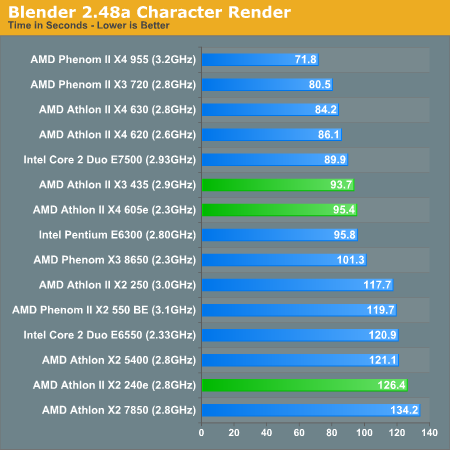AMD's Athlon II X3 435 & New Energy Efficient CPUs: Killing Intel Below $90
by Anand Lal Shimpi on October 20, 2009 12:00 AM EST- Posted in
- CPUs
3dsmax 9 - SPECapc 3dsmax CPU Rendering Test
Today's desktop processors are more than fast enough to do professional level 3D rendering at home. To look at performance under 3dsmax we ran the SPECapc 3dsmax 8 benchmark (only the CPU rendering tests) under 3dsmax 9 SP1. The results reported are the rendering composite scores:

Compared to the Intel dual-core options, the Athlon II X3 435 is a definite winner here. It's got the core count and clock speed to beat the old Penryn derivatives. Its biggest competition comes from its own family, the Athlon II X4 620 is the better buy here.
Cinebench R10
Created by the Cinema 4D folks we have Cinebench, a popular 3D rendering benchmark that gives us both single and multi-threaded 3D rendering results.

As I've been mentioning this entire time, the Athlon II X3 435 doesn't really sacrifice clock speed in its three-core configuration. At 2.9GHz even its single threaded performance is comparable to the Pentium E6300. Run a multithreaded app however and the performance goes from parity to leading:

POV-Ray 3.73 beta 23 Ray Tracing Performance
POV-Ray is a popular, open-source raytracing application that also doubles as a great tool to measure CPU floating point performance.
I ran the SMP benchmark in beta 23 of POV-Ray 3.73. The numbers reported are the final score in pixels per second.

The POV-Ray results echo what we've been seeing thus far, vs. Intel there's no contest - the 435 is the better value. Compared to the quad-core Athlon IIs however, the 435 isn't very good.
Blender 2.48a
Blender is an open source 3D modeling application. Our benchmark here simply times how long it takes to render a character that comes with the application.











177 Comments
View All Comments
blackbyron - Tuesday, October 20, 2009 - link
you don't really understand what I'm talking about. I am not talking about how good AMD is. I'm talking about business. Business is Business. Have you heard about Intel been fined for 1.45 billion dollars because of lawsuit? Intel does something illegal. If you don't believe and not satisfy what I said, google is your friend.Are you going get angry that Intel will start at $400 on quad core? Doesn't that make you worry?
qwertymac93 - Tuesday, October 20, 2009 - link
it seems a dual core is completely pointless when you can get a quad for a few $ more. any clock speed difference can be made up from overclocking, and power consumption isn't really that much higher. the dual core athlon seems to only have a place in notebooks, were a 10 watt increase can kill any demand for a product. in time the dual cores will fade out and only be seen in notebooks. with phenoms costing twice as much to make, i dont think they even make sense, why not make an 8-core athlon ll for the same die size?maddoctor - Tuesday, October 20, 2009 - link
Only AMD worshiper will buy its products. AMD will never win the benchmark. Don't to become an AMD worshiper, get a life and buy Intel powered product.pullmyfoot - Tuesday, October 20, 2009 - link
dude, shut up man. how old are you? 5?maddoctor - Tuesday, October 20, 2009 - link
Are you mad? I belive currently you are using Intel based products, and further you will be using Intel products only because AMD will be no more in 2011.vexingv - Tuesday, October 20, 2009 - link
Anand's conclusion really sums it up. On the low end, AMD has got it locked. But AMD really has a busy product segment between the Athlon II X2, X3, and X4's. My quandary: I'm giving my current HTPC (AthlonX2 4200+) to my parents and was planning on replacing it with a new Athlon II setup. However, my main PC is an e7200. Now I don't know whether I should go low end (X2 240) for the HTPC or move up a bit (X3 435 or X4 620) and have my old E7200 be the basis of the HTPC and use the AMD system as my new main PC.decisions, decisions...
maddoctor - Tuesday, October 20, 2009 - link
Whatever AMD product throws to market, rubbish is a rubbish. Intel products prices will make AMD's prices room tighter, and AMD is going to sink into oblivion. I love it because Intel prices will be cheaper to consumer.SunSamurai - Sunday, November 1, 2009 - link
http://www.anandtech.com/bench/default.aspx?p=96&a...">http://www.anandtech.com/bench/default.aspx?p=96&a...Thats a less expensive AMD CPU out preforming a more expensive Intel CPU
Suck on that a while.
Eeqmcsq - Tuesday, October 20, 2009 - link
AMD has 13 Athlon IIs, 6 energy efficient, 7 normal CPUs, ranging from $60 to $143, with a quite a few overlapping processors. That's not even counting the Phenom IIs in that price range. Some of these might be OEM specific only, so that would simplify the lineup for the individual buyer. Even still, that's a lot of questions the buyer has to face? Faster dual core? Medium triple core? Slower quad core? Energy efficient/low heat? L3 cache?I guess one can say there's an Athlon II that will fits anyone's needs at this price range, but figuring out which is the harder part.
Ezz777 - Tuesday, October 20, 2009 - link
Or stretch your budget to whatever an i5 is going for and get the best of both worlds...I'm currently budgeting for a new PC, and i find it hard to justify this sort of price point for a CPU. I'm not strictly Intel/AMD aligned but i just feel the i5 seems to answer most of these questions.
So...I guess then my question is what sort of budget for a Entry / Mid gaming PC would justify these CPUs?
And secondly, is there a rule of thumb you all use for what proportion of a PC you should spend on the CPU (or GPU for that matter)?
Clearly this will change due to the various offerings, but would does 25% CPU, 50% GPU, 25% M/B etc. sound about right?